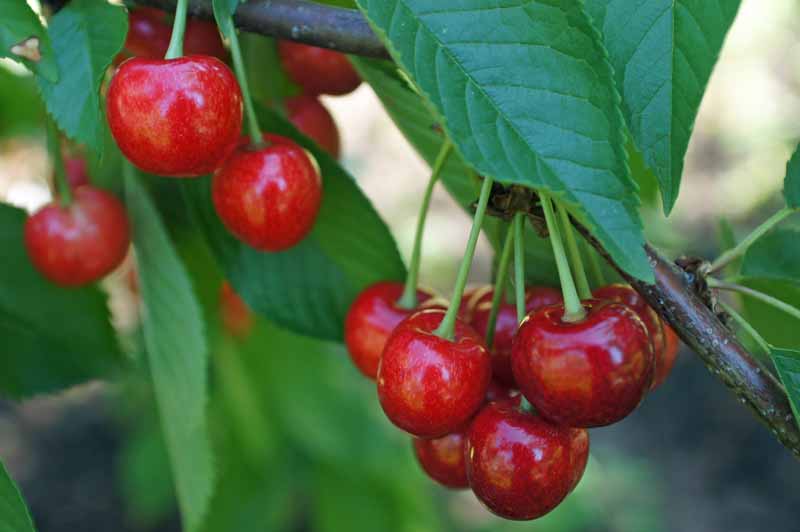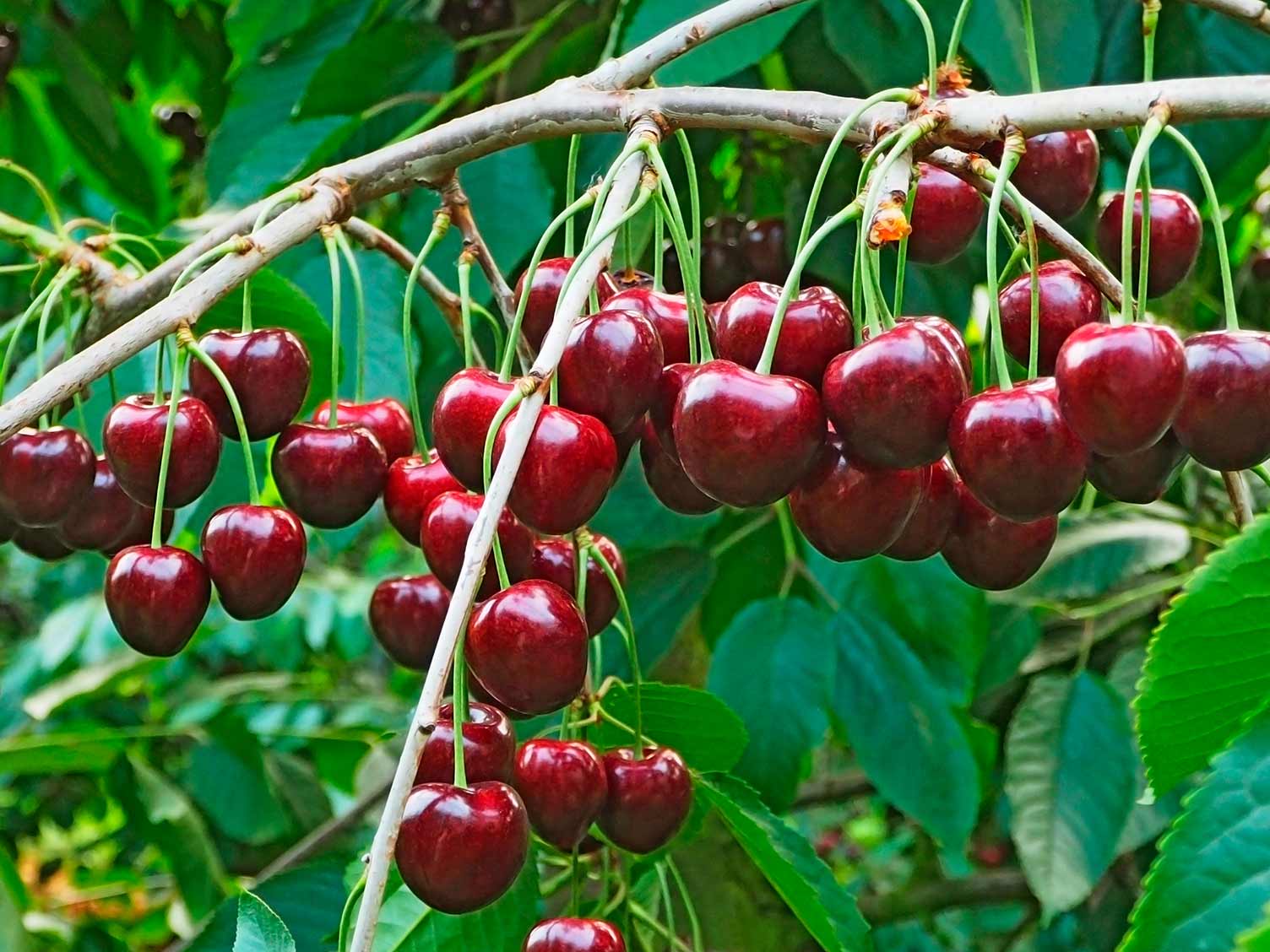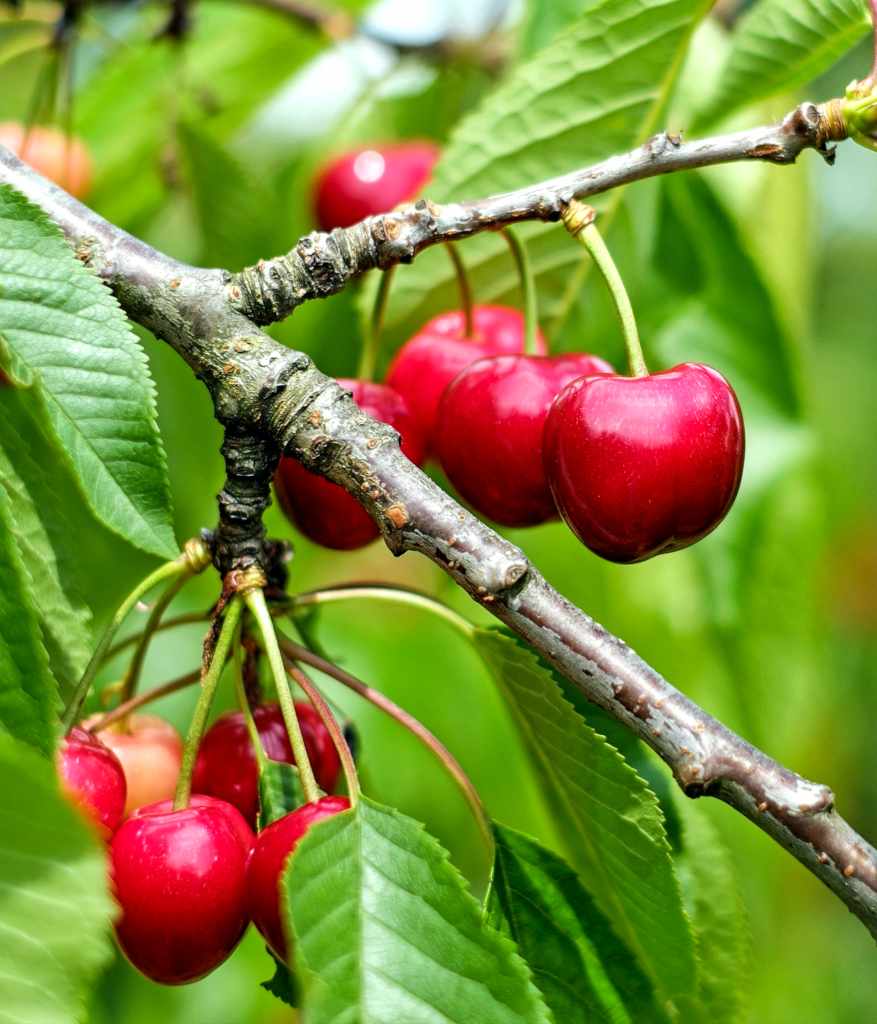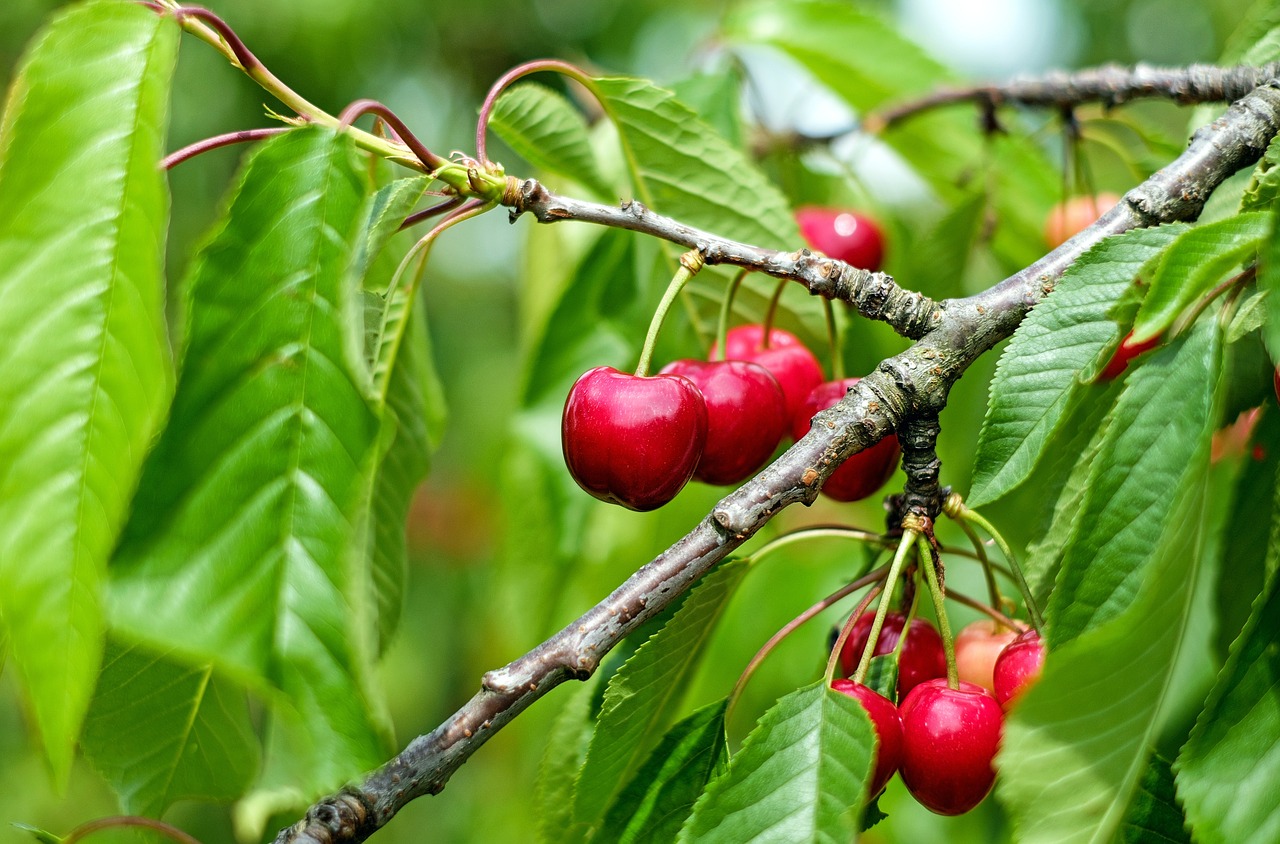Understanding the Basics of Cherry Cultivation
Cherry cultivation is a fascinating process that requires a deep understanding of the plant’s growth habits and characteristics. With over 1,000 varieties of cherries worldwide, it’s essential to recognize the differences between sweet cherries, sour cherries, and duke cherries. Sweet cherries, for instance, are typically grown on trees, while sour cherries are often found on bushes. But do cherries grow on trees or bushes? The answer lies in the specific type of cherry plant.
Cherry plants can be broadly classified into two categories: trees and bushes. Cherry trees, also known as Prunus avium, are deciduous trees that can grow up to 30 feet tall. They have a single trunk, a rounded crown, and a deep root system. Cherry bushes, on the other hand, are smaller, shrub-like plants that typically grow up to 6 feet tall. They have multiple stems, a more compact root system, and are often used for hedging or landscaping.
Understanding the growth habits of cherry plants is crucial for successful cultivation. Cherry trees, for example, require full sun, well-drained soil, and regular pruning to promote healthy growth. Cherry bushes, by contrast, are more tolerant of shade and require less maintenance. By recognizing the unique characteristics of each type of cherry plant, growers can provide the optimal conditions for their plants to thrive.
In addition to understanding the growth habits of cherry plants, it’s also essential to recognize the different types of cherries and their uses. Sweet cherries, for instance, are perfect for fresh eating, while sour cherries are often used for baking and cooking. Duke cherries, a hybrid of sweet and sour cherries, offer the best of both worlds and are ideal for fresh eating and cooking.
By grasping the basics of cherry cultivation, growers can unlock the secrets of successful cherry growth. Whether you’re a seasoned grower or a beginner, understanding the unique characteristics of cherry plants is the key to enjoying a bountiful harvest of delicious cherries.
Do Cherries Grow on Trees or Bushes: Separating Fact from Fiction
One of the most common questions among cherry enthusiasts is, “Do cherries grow on trees or bushes?” The answer is not a simple one, as it depends on the specific type of cherry plant. While some cherries grow on trees, others grow on bushes, and understanding the differences between these two types of plants is essential for successful cultivation.
Cherry trees, also known as Prunus avium, are deciduous trees that can grow up to 30 feet tall. They have a single trunk, a rounded crown, and a deep root system. These trees are ideal for large gardens or orchards, and they produce delicious sweet cherries that are perfect for fresh eating. On the other hand, cherry bushes, also known as Prunus fruticosa, are smaller, shrub-like plants that typically grow up to 6 feet tall. They have multiple stems, a more compact root system, and are often used for hedging or landscaping.
So, do cherries grow on trees or bushes? The answer is both Sweet cherries, like the popular Bing and Rainier varieties, grow on trees, while sour cherries, like the Montmorency and Balaton varieties, grow on bushes. Duke cherries, a hybrid of sweet and sour cherries, can grow on either trees or bushes, depending on the specific variety.
Understanding the differences between cherry trees and bushes is crucial for providing the optimal growing conditions for your plants. Cherry trees require full sun, well-drained soil, and regular pruning to promote healthy growth, while cherry bushes are more tolerant of shade and require less maintenance.
In addition to understanding the growth habits of cherry plants, it’s also essential to recognize the different types of cherries and their uses. Sweet cherries are perfect for fresh eating, while sour cherries are often used for baking and cooking. Duke cherries offer the best of both worlds and are ideal for fresh eating and cooking.
By separating fact from fiction and understanding the differences between cherry trees and bushes, growers can unlock the secrets of successful cherry growth. Whether you’re a seasoned grower or a beginner, knowing the answer to the question “do cherries grow on trees or bushes” is the first step towards enjoying a bountiful harvest of delicious cherries.
The Anatomy of a Cherry Tree: Understanding the Structure and Growth Patterns
A cherry tree is a complex organism consisting of various parts that work together to produce delicious fruit. Understanding the anatomy of a cherry tree is essential for providing the optimal growing conditions and care for your plants. In this section, we will delve deeper into the structure and growth patterns of cherry trees, including the root system, trunk, branches, and leaves.
The root system of a cherry tree is made up of a taproot and a network of smaller roots that absorb water and nutrients from the soil. The taproot can grow up to 6 feet deep, while the smaller roots can spread out up to 10 feet in diameter. A healthy root system is crucial for the overall health and productivity of the tree.
The trunk of a cherry tree is the main stem that supports the branches and leaves. It can grow up to 30 feet tall and 1 foot in diameter. The trunk is covered with a layer of bark that protects the tree from disease and pests. As the tree grows, the trunk will develop a characteristic shape and texture.
The branches of a cherry tree are the structures that produce the leaves, flowers, and fruit. They can grow up to 10 feet long and are covered with a layer of leaves that absorb sunlight and carbon dioxide. The branches are also responsible for producing the fruiting spurs, which are the small twigs that produce the flowers and fruit.
The leaves of a cherry tree are the food factories of the plant, responsible for absorbing sunlight and carbon dioxide and producing glucose and oxygen. They are typically 2-4 inches long and have a pointed tip and serrated edges. The leaves are also responsible for regulating the tree’s water balance and temperature.
Understanding the anatomy of a cherry tree is essential for providing the optimal growing conditions and care for your plants. By recognizing the different parts of the tree and their functions, you can provide the necessary support and maintenance to promote healthy growth and fruit production. Whether you’re growing cherries on trees or bushes, understanding the anatomy of the plant is crucial for success.
How to Grow Cherries: Tips for Planting and Caring for Cherry Trees or Bushes
Growing cherries can be a rewarding experience, but it requires careful planning and attention to detail. Whether you’re growing cherries on trees or bushes, following these tips will help you achieve success.
Planting is the first step in growing cherries. Choose a location with full sun and well-drained soil. Cherry trees prefer a slightly acidic soil pH, between 6.0 and 6.5. Plant the tree or bush in the early spring or fall, when the weather is cooler. Water thoroughly after planting and keep the soil consistently moist during the first year.
Pruning is an essential part of cherry tree care. Prune the tree annually to maintain its shape, promote fruiting, and remove diseased or damaged branches. Prune cherry bushes in the late winter or early spring, removing any dead or damaged stems.
Watering is critical for cherry trees and bushes. Water regularly, providing about 1 inch of water per week. Avoid overwatering, which can lead to disease and root rot. Mulch around the base of the tree or bush to retain moisture and suppress weeds.
Fertilizing is also important for cherry trees and bushes. Feed the tree or bush with a balanced fertilizer in the early spring, following the manufacturer’s instructions. Avoid overfertilizing, which can damage the tree or bush.
Pest and disease management is also crucial for growing cherries. Keep an eye out for common pests like aphids, spider mites, and cherry fruit flies. Regularly inspect the tree or bush for signs of disease like powdery mildew, black knot, and brown rot. Use organic or integrated pest management techniques to control any issues that arise.
By following these tips, you’ll be well on your way to growing delicious cherries, whether on trees or bushes. Remember to be patient, as cherry trees and bushes take time to mature. With proper care and attention, you’ll enjoy a bountiful harvest of juicy, sweet cherries.
Cherry Bushes vs. Cherry Trees: Which is Better for Your Garden?
When it comes to growing cherries, one of the most common debates is whether to grow cherry bushes or cherry trees. Both options have their pros and cons, and the right choice for your garden depends on several factors, including space, maintenance needs, and fruit production.
Cherry bushes are a great option for small gardens or containers. They are compact, easy to care for, and produce fruit within 2-3 years of planting. Cherry bushes are also more tolerant of shade and can thrive in partial shade conditions. However, they may require more frequent pruning to maintain their shape and promote fruiting.
Cherry trees, on the other hand, are a better option for larger gardens or orchards. They can grow up to 30 feet tall and produce more fruit than cherry bushes. Cherry trees also require less maintenance than cherry bushes, as they are less prone to disease and pests. However, they may require more space and can take longer to produce fruit, typically 5-7 years after planting.
Another factor to consider is the type of cherry you want to grow. Sweet cherries, like Bing and Rainier, are typically grown on trees, while sour cherries, like Montmorency and Balaton, are often grown on bushes. Duke cherries, a hybrid of sweet and sour cherries, can be grown on either trees or bushes.
Ultimately, the decision between cherry bushes and cherry trees comes down to your personal preferences and garden conditions. If you have limited space and want a low-maintenance option, cherry bushes may be the better choice. However, if you have a larger garden and want to produce more fruit, cherry trees may be the way to go.
Regardless of which option you choose, make sure to provide your cherry plants with the right conditions, including full sun, well-drained soil, and regular watering. With proper care and attention, you’ll be enjoying delicious cherries in no time.
Common Challenges and Solutions for Growing Cherries
Growing cherries can be a rewarding experience, but it’s not without its challenges. Cherry growers often face issues with pests, diseases, and climate-related problems that can impact fruit production and tree health. In this section, we’ll discuss some common challenges and provide solutions and tips for overcoming them.
Pests are a common problem for cherry growers. Aphids, spider mites, and cherry fruit flies are just a few of the pests that can damage cherry trees and bushes. To manage pests, use integrated pest management techniques such as introducing beneficial insects, practicing good sanitation, and using organic or chemical controls as needed.
Diseases are another challenge for cherry growers. Powdery mildew, black knot, and brown rot are just a few of the diseases that can impact cherry trees and bushes. To manage diseases, practice good sanitation, remove infected branches, and use fungicides as needed.
Climate-related issues are also a challenge for cherry growers. Cherry trees and bushes are sensitive to extreme temperatures, drought, and excessive moisture. To manage climate-related issues, provide adequate water and nutrients, and protect trees and bushes from extreme weather conditions.
Soil-related issues are also a challenge for cherry growers. Cherry trees and bushes prefer well-drained soil with a pH between 6.0 and 6.5. To manage soil-related issues, test your soil regularly and amend it as needed.
By understanding the common challenges faced by cherry growers and taking steps to manage them, you can ensure a healthy and productive cherry crop. Whether you’re growing cherries on trees or bushes, with the right knowledge and techniques, you can overcome any obstacle and enjoy a bountiful harvest of delicious cherries.
Harvesting Cherries: When and How to Pick Your Fruit
Harvesting cherries is an exciting time for cherry growers, as it marks the culmination of months of hard work and dedication. But when is the best time to pick cherries, and how should you go about it? In this section, we’ll explore the best practices for harvesting cherries, including when to pick, how to pick, and how to handle the fruit after harvesting.
The best time to pick cherries depends on the variety, but generally, cherries are ready to harvest in late spring to early summer. Check the cherries regularly for ripeness, as they can quickly go from unripe to overripe. For sweet cherries, look for a deep red color and a slightly soft texture. For sour cherries, look for a bright red color and a firm texture.
When picking cherries, use a gentle touch to avoid damaging the fruit or the tree. Use a ladder or step stool to reach the higher branches, and consider using a cherry picker or fruit picker to make the process easier. Handle the cherries carefully, as they can be easily bruised or damaged.
After harvesting, handle the cherries with care to ensure they remain fresh and flavorful. Store the cherries in a cool, dry place, away from direct sunlight and heat. Use a breathable container, such as a paper bag or a mesh bag, to allow for airflow and prevent moisture buildup.
For longer-term storage, consider freezing or canning the cherries. Freezing cherries is a simple process that involves washing, drying, and freezing the fruit. Canning cherries is a bit more involved, but it allows for longer-term storage and can be a great way to enjoy cherries year-round.
By following these best practices for harvesting cherries, you can enjoy a bountiful and delicious crop of cherries, whether you’re growing them on trees or bushes. Remember to handle the fruit with care, store it properly, and consider preserving it for longer-term enjoyment.
Conclusion: Growing Cherries with Confidence
Growing cherries can be a rewarding experience, but it requires a deep understanding of the basics of cherry cultivation. By following the tips and guidelines outlined in this article, you can unlock the secrets of cherry growth and enjoy a bountiful harvest of delicious cherries, whether you’re growing them on trees or bushes.
Remember, the key to successful cherry growth is to provide the right conditions, including full sun, well-drained soil, and regular watering. Prune your cherry trees or bushes regularly to promote healthy growth and fruit production, and be mindful of common challenges like pests, diseases, and climate-related issues.
By understanding the anatomy of a cherry tree, including the root system, trunk, branches, and leaves, you can better appreciate the complexity and beauty of these amazing plants. And by following the best practices for harvesting cherries, you can enjoy your fruit at its peak ripeness and flavor.
So, do cherries grow on trees or bushes? The answer is both With the right knowledge and techniques, you can grow delicious cherries on either trees or bushes, and enjoy the many benefits of these amazing fruits.
Thank you for reading this comprehensive guide to growing cherries. We hope you have found the information helpful and informative, and that you will use it to grow your own delicious cherries with confidence.








